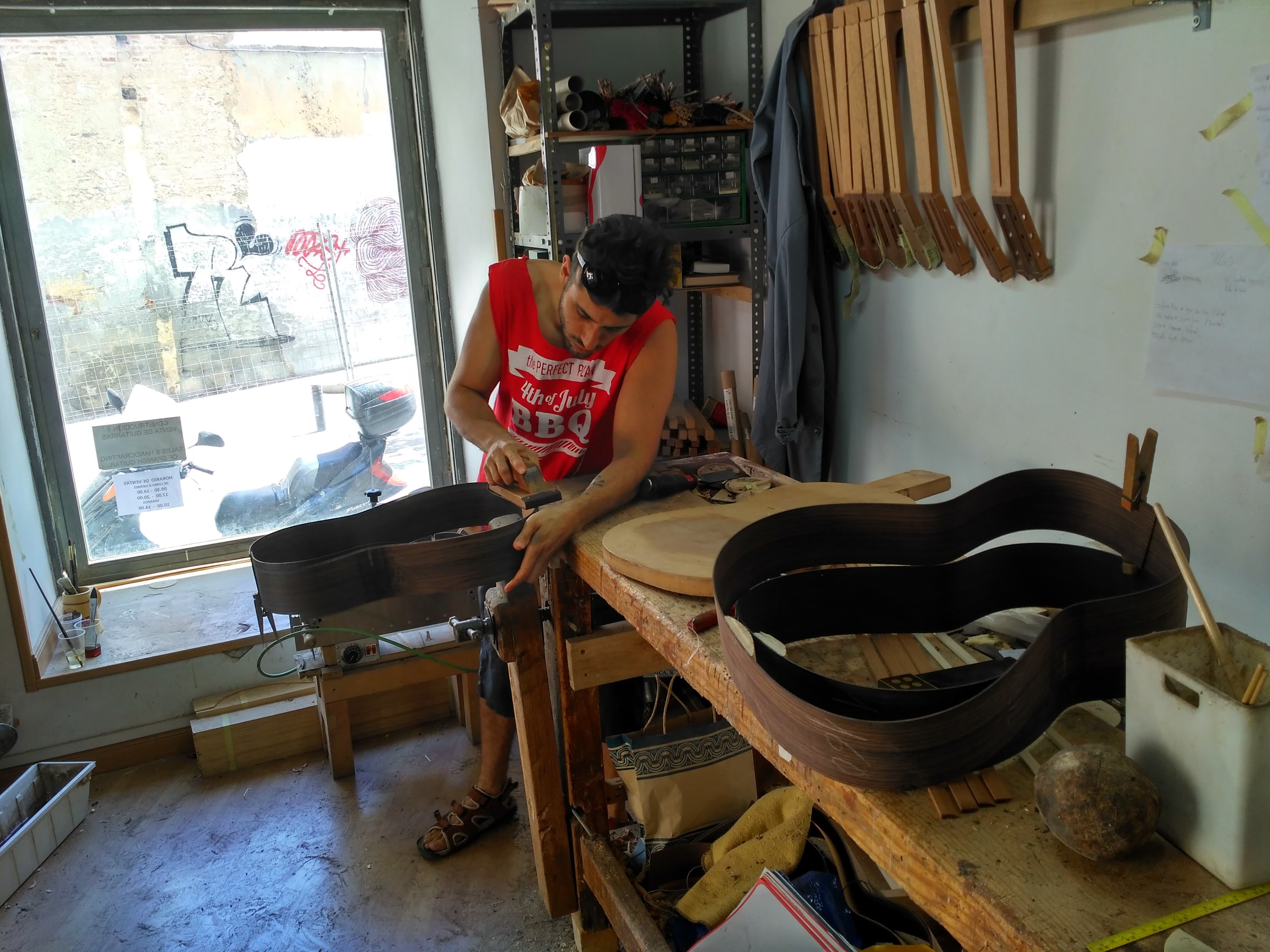|
Paolo Antonio Testore
Paolo Antonio Testore (born 1700 - died 1767) was a Milanese luthier. He was born in Milan, the second son of Carlo Giuseppe Testore, also a noted luthier, and worked out of the family's workshop under the "Sign of the Eagle" on Contrada Larga in Milan. He was one of the three finest instrument-makers from the Testore family, but a distinctive characteristic of Paolo Antonio's work is that he often omitted purfling and sometimes used lower quality wood. Testore's brother Carlo Antonio Testore Carlo Antonio Testore (1687–1765) was a Milanese luthier. Life and career Carlo Antonio Testore was born in Milan Milan ( , , ; ) is a city in northern Italy, regional capital of Lombardy, the largest city in Italy by urban area a ... was also a luthier, and their sons Giovanni, son of Carlo, and Gennaro(?), son of Paolo, continued the family business in Milan during the 1760s. References {{DEFAULTSORT:Testore, Paolo Antonio 1700 births 1767 deaths Italian luthiers ... [...More Info...] [...Related Items...] OR: [Wikipedia] [Google] [Baidu] |
Luthier
A luthier ( ; ) is a craftsperson who builds or repairs string instruments. Etymology The word ' is originally French and comes from ''luth'', the French word for "lute". The term was originally used for makers of lutes, but it came to be used in French for makers of most bowed and plucked stringed instruments such as members of the violin family (including violas, cellos, and double basses) and guitars. Luthiers, however, do not make harps or pianos; these require different skills and construction methods because their strings are secured to a frame. Craft The craft of luthiers, lutherie (rarely called "luthiery", but this often refers to stringed instruments other than those in the violin family), is commonly divided into the two main categories of makers of stringed instruments that are plucked or strummed and makers of stringed instruments that are bowed. Since bowed instruments require a bow, the second category includes a subtype known as a bow maker or archetier ... [...More Info...] [...Related Items...] OR: [Wikipedia] [Google] [Baidu] |
Milan
Milan ( , , ; ) is a city in northern Italy, regional capital of Lombardy, the largest city in Italy by urban area and the List of cities in Italy, second-most-populous city proper in Italy after Rome. The city proper has a population of nearly 1.4 million, while its Metropolitan City of Milan, metropolitan city has 3.2 million residents. Within Europe, Milan is the fourth-most-populous List of urban areas in the European Union, urban area of the EU with 6.17 million inhabitants. According to national sources, the population within the wider Milan metropolitan area (also known as Greater Milan) is estimated between 7.5 million and 8.2 million, making it by far the List of metropolitan areas of Italy, largest metropolitan area in Italy and List of metropolitan areas in Europe, one of the largest in the EU.* * * * Milan is the economic capital of Italy, one of the economic capitals of Europe and a global centre for business, fashion and finance. Milan is reco ... [...More Info...] [...Related Items...] OR: [Wikipedia] [Google] [Baidu] |
Carlo Giuseppe Testore
Carlo Giuseppe Testore (c. 1665–1738) was an Italian luthier, who worked in his later life in Milan. Biography Testore was born in Novara. A student of Giovanni Grancino, he went to Milan in 1687 and set up his workshop at the Sign of the Eagle ("All'aquila") in the Contrada Larga in Milan. His two sons, Carlo Antonio Testore (1688after 1764) and Paolo Antonio Testore (1690after 1760), students of their father, also worked as luthiers in Milan. Giovanni, son of Carlo, and (?Genn)-aro, son of Paolo, continued the workshop in Milan during the 1760s. Testore instruments today Carlo Giuseppe Testore is especially valued for his double basses. Currently, Russian violist Yuri Bashmet plays a Paolo Antonio Testore instrument. National Arts Centre Orchestra's former principal cellist Amanda Forsyth uses a Testore cello, manufactured in 1699, as does solo cellist Jacob Shaw (musician), Jacob Shaw with a cello of unknown date, belonging to the Royal Danish Academy of Music collection. ... [...More Info...] [...Related Items...] OR: [Wikipedia] [Google] [Baidu] |
Purfling
Purfling is a narrow decorative edge inlaid into the top plate and often the back plate of a stringed instrument. It was originally made of laminated strips of wood, and later nacre and other hard inlay materials. Plastic is commonly used in modern mass-produced instruments. Purfling may affect the instrument's acoustics. Purfling is distinct from binding, which is used primarily to control moisture rather than decoration. Inexpensive instruments may simulate purfling with paint. Description and history Purfling is a narrow decorative edge inlaid into the top plate and often the back plate of a stringed instrument. Purfling was originally made of laminated strips of wood, often contrasting in color as a visual accent. The earliest known example of purfling is on a violin made by Andrea Amati in 1564, now on display in the Ashmolean Museum at Oxford University. It consists of two outer strips of pearwood stained black and an inner strip of poplar. Eventually, nacre from shel ... [...More Info...] [...Related Items...] OR: [Wikipedia] [Google] [Baidu] |
Carlo Antonio Testore
Carlo Antonio Testore (1687–1765) was a Milanese luthier. Life and career Carlo Antonio Testore was born in Milan Milan ( , , ; ) is a city in northern Italy, regional capital of Lombardy, the largest city in Italy by urban area and the List of cities in Italy, second-most-populous city proper in Italy after Rome. The city proper has a population of nea ..., the son of Carlo Giuseppe Testore, also a noted luthier, and worked in the family's workshop under the "Sign of the Eagle" on Contrada Larga in Milan. The workmanship and appearance of his instruments is considered rough, but the tonal quality is excellent. One of his basses was owned and played by the noted bassist Giovanni Bottesini. He was prolific, and most active as a luthier from 1715 to 1745. His violincellos are highly prized. Testore's brother Paolo Antonio Testore was also a luthier, and their sons Giovanni, son of Carlo, and Gennaro(?), son of Paolo, continued the family business in Milan during th ... [...More Info...] [...Related Items...] OR: [Wikipedia] [Google] [Baidu] |
1700 Births
As of March 1 (Old Style, O.S. February 19), where the Julian calendar acknowledged a leap day and the Gregorian calendar did not, the Julian calendar fell one day further behind, bringing the difference to 11 days until February 28 (Old Style, O.S. February 17), 1800. In Sweden, the year started in the Julian calendar and remained so until February 28. Then, by skipping the leap day, the Swedish calendar was introduced, letting Wednesday, February 28, be followed by Thursday, March 1, giving the entire year the same pattern as a common year starting on Monday, similar to the calendars of 2001, 2007, and 2018. This calendar, being ten days behind the Gregorian and one day ahead of the Julian, lasts until 1712. Events January–March * January 1 – Protestantism, Protestant nations in Western Europe, except Kingdom of England, England, start using the Gregorian calendar. Catholic Church, Catholic nations have been using the Gregorian calendar since its introduction in ... [...More Info...] [...Related Items...] OR: [Wikipedia] [Google] [Baidu] |
1767 Deaths
Events January–March * January 1 – The first annual volume of ''The Nautical Almanac and Astronomical Ephemeris'', produced by British Astronomer Royal Nevil Maskelyne at the Royal Observatory, Greenwich, gives navigators the means to find longitude at sea, using tables of lunar distance. * January 9 – William Tryon, governor of the Royal Colony of North Carolina, signs a contract with architect John Hawks to build Tryon Palace, a lavish Georgian style governor's mansion on the New Bern waterfront. * February 16 – On orders from head of state Pasquale Paoli of the newly independent Republic of Corsica, a contingent of about 200 Corsican soldiers begins an invasion of the small island of Capraia off of the coast of northern Italy and territory of the Republic of Genoa. By May 31, the island is conquered as its defenders surrender.George Renwick, ''Romantic Corsica: Wanderings in Napoleon's Isle'' (Charles Scribner's Sons, 1910) p230 * February 19 ... [...More Info...] [...Related Items...] OR: [Wikipedia] [Google] [Baidu] |
Italian Luthiers
Italian(s) may refer to: * Anything of, from, or related to the people of Italy over the centuries ** Italians, a Romance ethnic group related to or simply a citizen of the Italian Republic or Italian Kingdom ** Italian language, a Romance language *** Regional Italian, regional variants of the Italian language ** Languages of Italy, languages and dialects spoken in Italy ** Italian culture, cultural features of Italy ** Italian cuisine, traditional foods ** Folklore of Italy, the folklore and urban legends of Italy ** Mythology of Italy, traditional religion and beliefs Other uses * Italian dressing, a vinaigrette-type salad dressing or marination * Italian or Italian-A, alternative names for the Ping-Pong virus, an extinct computer virus * ''Italien'' (magazine), pro-Fascist magazine in Germany between 1927 and 1944 See also * * * Italia (other) * Italic (other) * Italo (other) * The Italian (other) * Italian people (other) Italian ... [...More Info...] [...Related Items...] OR: [Wikipedia] [Google] [Baidu] |





